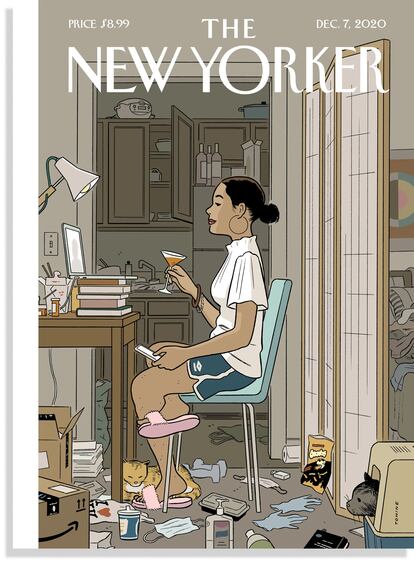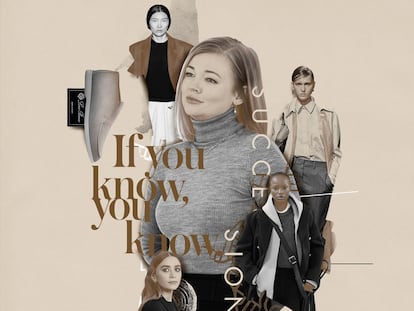No suit and tie, but also no shorts. Does anyone know what to wear in an office these days?
The decline of formal attire in the workplace leads to a more comfortable yet somewhat perplexing environment

In 2020, confusion reverberated throughout the planet, and the fashion industry was not spared. Confinement measures forced us to radically change our habits and needs. Scott Sternberg founded Entireworld after his previous menswear brand — Band of Outsiders — went bankrupt. He had concerns about the future, wondering who would buy clothes when everyone was staying at home. To Sternberg’s surprise, Entireworld experienced its best sales ever when his colorful tracksuits became a hit. While other brands struggled, Entireworld thrived. Sternberg had unintentionally predicted a trend: formal attire faded away while comfort became the new norm.
Since then, many things have changed, including the way we dress in professional settings, where unwritten codes used to apply. After months of video calls during which only the top half of our bodies were visible, it seems that a silent shift in thinking has convinced us that certain formalities are no longer necessary. This mindset change has even been observed in the top echelon of power. Last year, during the G7 meeting in Germany, the leaders of the world’s largest economies were photographed without ties for the first time in the 40-year history of these summits. The New York Times published an article about attire in the U.S. Senate, where it’s no longer odd to see someone wearing a sweatshirt. The pandemic accelerated a phenomenon that designer Tom Ford had foreseen in a 1999 interview. “We spend so much time working in front of a computer these days… I mean, we could be in our underwear and T-shirt. Who cares? Who’s going to see us anyway?”
Death of the suit-armor
“The pandemic was a time when we all started to ask ourselves questions like, ‘What do I really want to do with my life? How do I want to work?’ And you know what? Fashion is always a reflection of society, so it’s always changing too,” said Manuel García, founder of the García Madrid men’s fashion firm. “The way we dress and the way we want to present ourselves to others has changed. We’re evolving towards a more relaxed daily fashion style, with a touch of sophistication for evenings and special events.” His company has always recognized these changes and is dedicated to offering a wider range of clothing that sets itself apart from the traditional suit. “Remote work and evolving social norms have prompted a shift in dressing habits, with new aesthetic work standards emerging. The casual style has taken the lead and shows no sign of reverting.” For García Madrid, this entails “ditching ties, pairing suits with sports shoes, and reserving suits for formal occasions rather than everyday life.”

The suit and tie combination suffered the most from this change. For decades, it was a symbol of a serious workplace image. While some environments had already discarded the outdated attire, the pandemic pushed it into oblivion. Food quality consultant Carlos Rey said, “When I started, they told us that suits were a consultant’s armor.” But the protective uniform that projected an air of aloof seriousness definitively disappeared during home confinement. “On one hand, when you’re more confident, you don’t feel the need to hide behind that armor. But on the other hand, after doing video calls, many folks have become more relaxed and realized that professionals don’t need to dress in formal suits and ties. We’ve seen each other in our homes, in our everyday situations. In the end, it’s become normal to see a client wearing a T-shirt,” he said.
A new office environment
In times of change, confusion often arises. Decades ago, dressing for work was as easy as pairing a tie with a suit. Nowadays, there are many more options. Where is the line between acceptable and too casual? As always, it depends on your perspective. “I do fashion consulting and design clothing and accessories. But I also have to pay attention to new fashion trends, and I can tell you that streetwear and urban fashion has really taken off lately,” said designer Rubén Gómez. “Now we see plenty of top executives wearing sneakers — Casual Friday has evolved into a daily dress code.”
The rise of streetwear, closely associated with urban luxury, is becoming increasingly popular in an era where successful business figures like Mark Zuckerberg and Elon Musk have shown us how they influence global consumers simply by wearing their limited-edition sneakers to the office. “Being well-dressed doesn’t mean putting on a suit anymore,” said María Payá, a specialist in men’s clothing at the WOW Concept store in Madrid. Sergio Pérez, Payá's coworker and streetwear specialist, said, “Technical fabrics offer more comfort. Suits are now paired with T-shirts for a relaxed style. Sneakers are preferred over formal shoes.”
Even though there have dress code changes in certain workplaces, it can still be challenging to break old habits. Business environments in Madrid and Barcelona do not offer the same stylistic freedom as Silicon Valley in California. “Whenever we go shopping, they always show us these very interesting products. But you know, Spanish men still have a bit of a hard time with them,” said Payá. “And there are plenty of people who just can’t part ways with their skinny jeans. With all the quarantine time spent on social media, people have become more brand-aware and are looking for those extra-special items.”
Nevertheless, some items are still taboo in certain work environments. “We’d never buy anything too out of the ordinary like super-loose or printed jeans, or colorful suits, except for some special pieces,” said Payá. Wearing shorts to the office is also frowned upon in most places. An editor with ICON magazine recalls being reprimanded at a previous job for wearing shorts. “One of my bosses told me, ‘Hey, the president is going to be mad if he sees you in those shorts.’ Being new, I had no clue, but she was totally right. You usually learn about a place’s dress code through trial and error, and sometimes a little scare.”
Sign up for our weekly newsletter to get more English-language news coverage from EL PAÍS USA Edition
Tu suscripción se está usando en otro dispositivo
¿Quieres añadir otro usuario a tu suscripción?
Si continúas leyendo en este dispositivo, no se podrá leer en el otro.
FlechaTu suscripción se está usando en otro dispositivo y solo puedes acceder a EL PAÍS desde un dispositivo a la vez.
Si quieres compartir tu cuenta, cambia tu suscripción a la modalidad Premium, así podrás añadir otro usuario. Cada uno accederá con su propia cuenta de email, lo que os permitirá personalizar vuestra experiencia en EL PAÍS.
¿Tienes una suscripción de empresa? Accede aquí para contratar más cuentas.
En el caso de no saber quién está usando tu cuenta, te recomendamos cambiar tu contraseña aquí.
Si decides continuar compartiendo tu cuenta, este mensaje se mostrará en tu dispositivo y en el de la otra persona que está usando tu cuenta de forma indefinida, afectando a tu experiencia de lectura. Puedes consultar aquí los términos y condiciones de la suscripción digital.
More information
Últimas noticias
Most viewed
- David King, chemist: ‘There are scientists studying how to cool the planet; nobody should stop these experiments from happening’
- Reinhard Genzel, Nobel laureate in physics: ‘One-minute videos will never give you the truth’
- Oona Chaplin: ‘I told James Cameron that I was living in a treehouse and starting a permaculture project with a friend’
- Mexico completes its trade shift with the entry into force of tariffs on China and countries without trade agreements
- Sinaloa Cartel war is taking its toll on Los Chapitos










































